In this preternaturally mild summer [2014] only the exorbitantly high transit fares and my volunteer work at Greater Astoria Historical Society are keeping me from roving all over town most days of the week, pointing a camera at anything remotely of interest. However, I do try to get out whenever possible and on this day, I was traveling in one of my favorite parts of town, the downtown Brooklyn area. There have been ForgottenTours in Brooklyn Heights and DUMBO the past couple of years, yet I have merely scratched the surface on what has always been a fascinating and ever-changing region.
I left off in Part 1 on Columbia Street along the remnants of Brooklyn’s industrial waterfront. I chose to turn east on DeGraw Street, named in the dawn of the City of Brooklyn for a now-forgotten-landowner, James DeGraw (but I’ll have more on why its name was changed east of here presently) mainly because I had never walked on DeGraw Street before, and I try to walk a street I’ve never been on at least once a week. I had to make a couple of detours, since DeGraw is interrupted by both the Gowanus Expressway and by the Gowanus Canal. Of course, when I think of DeGraw or anything ending in “graw” I tend to think of this guy. Or this guy. Or even this guy.

Excuse me while I use Google Street View for a couple of things. Here’s #60 Tiffany Place on the corner of DeGraw — a fascinating street, since it retains its old Belgian block pavement and is lined with factory buildings that have been converted to residential units. (Tiffany Place is not named for who you think; see Part 1.) One of these is #60, a brick factory building constructed in a no-frills, brick fashion in the 1920s, with conversion completed in 2005. Here’s a photo of one of the interiors on Corcoran [which will be taken down when the apartment is sold, so check it now].
The problem is, the renovators added an out-of context 4th floor, which looks nothing like the rest of the facade. Would it have killed them to match the brick facing?
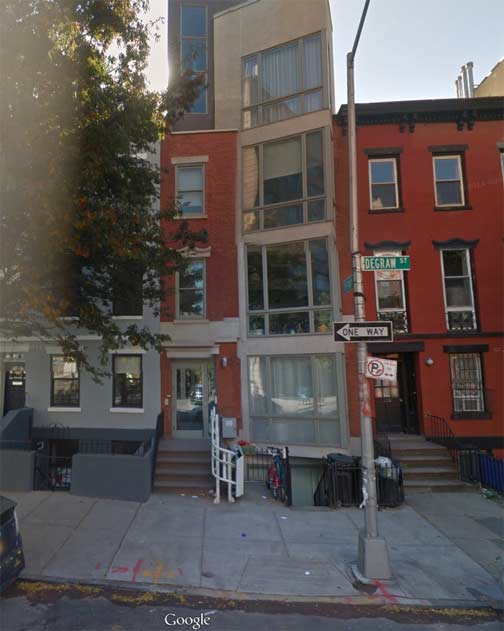
Here’s a bird of a different feather across the street at #140 DeGraw, across from the Tiffany Place conversion. This was a row house closely resembling #138, on the right, but it was gutted with a jutting, angled exterior and an additional floor. To me it is a more extravagant version of the townhouse on West 11th destroyed by Weathermen domestic terrorists and rebuilt with a jutting bay window. No bombs went off here — just a modern version of an old classic that retains a good deal of the older facade. I like the mix. Brownstoner has an interior photo.

I had to cross the expressway on Union Street and then walk along Hicks to resume on DeGraw. Across the highway here is #63 Tiffany Place; when this was an early residential conversion in the 1980s to the Tiffany Mews it was originally meant as low-income housing. These days, a one-BR is $2200 a month, however.

A typical 3-floor walkup brick building at DeGraw and Cheever Place. It’s one of four short Places that run between DeGraw and Kane streets west of Court Street: Tompkins, Strong, Cheever and Tiffany. Cheever is lined on both sides with handsome brick apartment buildings with steps and railings.

Crossing Henry Street you find this small restaurant tucked into a storefront on one of the very small DeGraw Street brick buildings that contain just two windows facing the street. According to yelp most of its business is takeout or delivery.
The former Strong Place Baptist Church, #215 DeGraw/#58 Strong Place, is considered one of the finest works of early Brooklyn ecclesiastic architect Minard Lafever, and according to historian Francis Morrone, his favorite among his Brooklyn churches, which also included St. Ann’s on Court Street; among his secular works were Packer Collegiate Institute on Joralemon Street and several buildings in Staten Island’s Sailors’ Snug Harbor. It was completed in 1852, just 2 years before Lafever’s death.
This 1857 illustration shows the church with several spires, but Morrone asserts they were never built. The original bell, cast in 1855 by the Meneely Bell Foundry in Troy, NY, is displayed on the exterior. The Strong Place Baptist Church is now located in a Court Street storefront; the church was used as a day care center and then sat empty for several years until its 2010 conversion into The Landmark at Strong Place residences.

Now crossing Clinton Street, at #249 DeGraw Street is what was originally the Trinity German Lutheran Church, built in 1905; after a few decades that church moved to Bay Ridge, Brooklyn and this church was home to the South Brooklyn 7th-Day Adventist Church (the Jehovah’s Witnesses). Today it is yet another residential conversion that has retained most of its old ecclesiastical elements, save its stained-glass windows. The architect was Theobald Engelhardt, another prolific architect of churches.
Crossing Court Street…
The former Brooklyn Fire Department Engine 4, #299 DeGraw Street, constructed about 1880, which later became FDNY Engine 204 after Brooklyn was absorbed into NYC in 1898. The firehouse was closed in 2003 despite neighborhood protest.

Simply structured brick buildings like this, in 2 or 3 stories, are the bread and butter of South Brooklyn’s (or as we call it now, Carroll Gardens’, Cobble Hill’s and Gowanus’) residential architecture, built to house 2 families, but these days sometimes more. This pair has the added attraction of eyelet attic windows.

This driveway features two “birdcage” lamps that were frequently seen in NYC parks on the Type B Henry Bacon-designed posts that first appeared in 1912 or so. Most of the “birdcages” succumbed to other models beginning in the 1970s.

St. Agnes Roman Catholic Church, one of the largest and tallest structures in South Brooklyn. The original church (Patrick Keely, arch.] was dedicated in 1888 on Hoyt Street between Sackett and DeGraw Streets by Brooklyn’s Bishop John Laughlin; after a fire claimed it in 1901, this much more massive edifice was designed by Thomas Houghton and dedicated in 1905. Its medieval Gothic Newark stone gargoyled tower is 130 feet tall and the nave, or central aisle, is 174 feet in length. 20 stained glass windows, imported from Munich, Germany, depict the life of St. Agnes of Rome. Two parishes, St. Paul’s on Court Street and St. Agnes, were combined in 2011 and the parish is now St. Paul and St. Agnes.
A pair of interesting buildings on DeGraw opposite the church: a former stable with picturesque brickwork and the parish rectory.
413 was built as a stable in 1892 for James Lumas for $3,000.
The imposing Italian Renaissance 421 DeGraw Street used to be the elementary school attached to St. Agnes Church. It was converted into a 90-unit apartment building in 1999 — it had been vacant for 12 years before that.
Past Bond Street, I have to detour again, as DeGraw Street dead-ends at the noxious and noisome Gowanus Canal. However, before I do that there is something to see at the stub end.
There’s a fenced-in area with what the Gowanus Canal Conservancy says are bird and bat houses. There are a number of organizations dedicated to cleaning up the foul-smelling canal, which ranks with Newtown Creek as among the most polluted waterways in the nation (see the link above for its history).

I detoured over to Union Street and crossed the bridge there over the canal, which gives me a chance to discuss a couple of things I may have missed on FNY’s previous Union Street page. This vintage Ford Model A is parked outside the Green Building, a former brass factory now home to a caterer. Its lengthy footprint makes it a unique location for wedding receptions. No doubt the vintage motorcar is associated with the hall.
An artist named Nantu (Raúl Ayala) has drawn fanciful renderings, titled Aqua Incognita, of the mutated denizens that may lurk beneath the impenetrable Gowanus Canal, as well as views of the Canal in a vintage era.
The Gowanus Canal was once a river full of life and a vital means of transport. By the Industrial Revolution, the canal grew to be very powerful, but in this progress came along fear, misconception and ultimately disregard for its natural strength. Like so many once foreceful properties of nature, we now witness neglect from commercial driven transformation throughout our landscapes.
I cannot cross the Canal without shooting a couple of photos. The famed tagger Inkhead has been here in recent weeks. Graffiti has always been part and parcel of the active or inactive rust-belt landscapes I tend to find myself in.

Ample Hills Creamery at Nevins and Union is one of a number of dessert palaces that have opened that are within a stone’s throw of the Canal (such as Four and Twenty Blackbirds on 3rd Avenue), along with an entire Whole Foods supermarket. As I didn’t want to spoil lunch and am saving pennies, I didn’t sample the fare, which includes “salty dark chocolate” and “hazelnut crack cookies covered in white chocolate pearls.” Yelp reviews are generally good.
Eh… make mine vanilla. What can I tell you? When I go to the Lemon Ice King of Corona, I have … the lemon ice.
I’m also suspicious of any comestible emporium anywhere near the noxious Canal, but what do I know?

This corner brick building at Nevins and Union has always been one of my neighborhood favorites. The painted lettering, National Packing Box Factory and James H. Dykeman, has held up well over a century.
James H. Dykeman’s box factory occupied this building on Union Street in Carroll Gardens. Dykeman “was a carpenter by trade who established himself in the box business in 1877,” according to The Disston Crucible, a Magazine for Millmen. “Two large buildings occupy the whole block at Union, Nevins, and Sackett Streets, the fourth side of the property facing the canal, making it possible to bring lumber to the mill very economically,” the article states. Ephemeral New York
Here, Frank Jump has a photo of the box factory in the early 20th Century as well as the Claireware pottery factory within.
Proteus Gowanus, a combination art space/exhibition venue/library/museum, also leases space in the former box museum. One Yelp reviewer says:
Very cool spot located along the Gowanus Canal. Walk in an unearth a mighty collection of artifacts from the days of Brooklyn lore! Old equipment, samples if water, newspaper clipping dating back to 16th century. This is a MUST see for any New Yorker interested in our fare city’s history!
In the classic Greek myths, Proteus was a sea or river god who could foretell the future, but change his shape, so that only those who could capture him could get the information out of him.
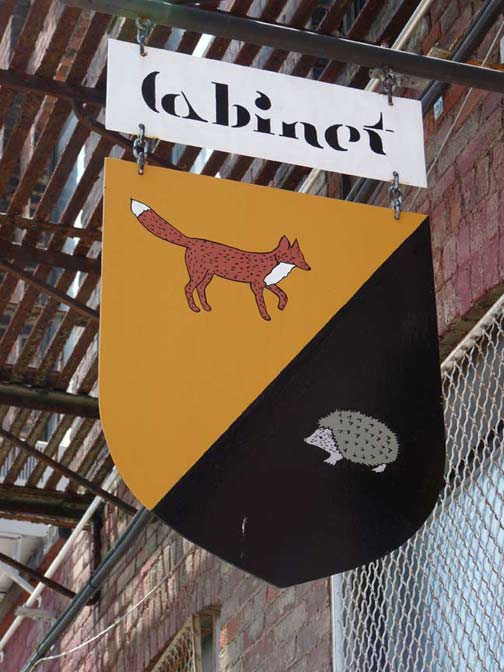
Cabinet Magazine, an art/culture quarterly, has offices in the box factory, as well as an exhibit space. Its banner, designed like a classic heraldry shield, features a fox and a hedgehog:
A few people emailed and asked about the flag and why our banner has a fox and a hedgehog (It’s not a porcupine!). The fox, they say, knows many small things, but the hedgehog knows one big thing. Isaiah Berlin wrote an essay on Tolstoy where he used these two animals to discuss different kinds of philosophers. Nietzsche, he says, is a fox; Dostoevsky is a hedgehog. Foxes can’t systematize; hedgehogs are the paradigmatic systematizers. According to Berlin, Tolstoy thought he was a hedgehog, but he was, in truth, a fox. Cabinet’s facebook page
Amidst all this highfalutin art and “artisanal” (which simply means “homemade”) ice cream, Gowanus is still Gowanus. Here’s Brooklyn Truck & Equipment Repair Co., on Nevins and DeGraw.

The T.E. Conklin Brass & Copper Co., Nevins and Sackett Streets.
T. E. Conklin manufactured brass, bronze and copper products. Located in Manhattan on Duane St. in 1894, they moved to Lafayette St. in 1922. Theodore Conklin died in 1924, but the company continued for many years after. Walter Grutchfield

The Gowanus Park apartment complex rises in the distance at Nevins and DeGraw. The 6-acre complex housing 1300 residents was completed in December 1966. It figured in the 1995 Harvey Keitel vehicle “Smoke.”
The Adams Book Company occupies a warehouse on Nevins between Sackett and DeGraw. The sign obscures the original name over the doorway on Sackett. According to their website, they have been in business since 1946 and [are] “the nation’s largest K-12 educational clearinghouse for new textbooks, used textbooks, new workbooks, paperback novels, and reference materials. We serve the K-12 educational community as a single source provider of any book in print. We are committed to supplying teachers with new paperback literature, new textbooks and reconditioned used textbooks all at the best possible prices.”
It was somewhat surprising to find a book distributer here on the banks of the filthy Gowanus!

Don’t litter. Would you? DeGraw between Nevins Street and 3rd Avenue.

A slight rise at 3rd Avenue and DeGraw Street allows a view of the St. Agnes near-cathedral on Hoyt Street seen previously.
Now that’s Gowanus: a machine yard at #580 DeGraw Street, officially DeGraw Iron Work Inc.

Amidst all this urbanity, a touch of green, or rather, Greene. The Thomas Greene Playground faces 3rd Avenue between DeGraw and Douglass. Greene was a tenant activist in the nearby Gowanus Park housing project.
In August 1776, during the Battle of Brooklyn, Gowanus saw some of the most brutal fighting of the Revolutionary War. During the battle, the British killed 256 American soldiers, and wounded or captured another hundred. General George Washington (1732-1799), nevertheless, masterminded a brilliant, nighttime retreat to Manhattan that ensured that the American Continental Army would live to fight another day. NYC Parks
Thomas Greene Park is the only spot in the immediate vicinity that approximates conditions found by British and American troops during the battle.

In an area undergoing about the same amount of change as the rest of western and northern Brooklyn (i.e., rapid) some things have remained unchanged, like this former sweatshop clothing manufacturer at 3rd Avenue and Douglass Street. Its old handpainted sign is still intact and in place. I hope this classic old building is rehabilitated to retain an approximation of its longtime appearance.

Across 3rd Avenue, the future is here, as a high-rise Marriott Fairfield Inn has sprung up at 3rd Avenue and Butler Street, across from the Wyckoff Gardens housing project.
On 3rd Avenue between DeGraw and Douglass is a former New York Daily News distributing plant; from here trucks would deliver the paper to newsstands in the vicinity. Founded in 1919, the News has always billed itself as “New York’s Picture Newspaper” since it relied more heavily on photos than more “sophisticated” papers like the New York Times. The News has always had a stylized representation of a Speed Graphic camera on its mast. It’s stil there, though it’s been simplified over the years.

Littlefield, at #622 DeGraw between 3rd and 4th Avenues, is a literal hole in the wall but appearances can be deceiving.
Located on an industrial block between Park Slope and Carroll Gardens, the space spans over 6,000 square feet and includes a landscaped courtyard, an industrial outer room lined with the works of local artists, and a fully equipped concert space to host local bands. The eco-touches include sound walls made from recycled tires, a bar constructed of salvaged bowling lanes, and wind-power energy. NY Magazine

Just across the street at #609 is this unusually-constructed building. The bottom floor may have been a garage or stable at one time.
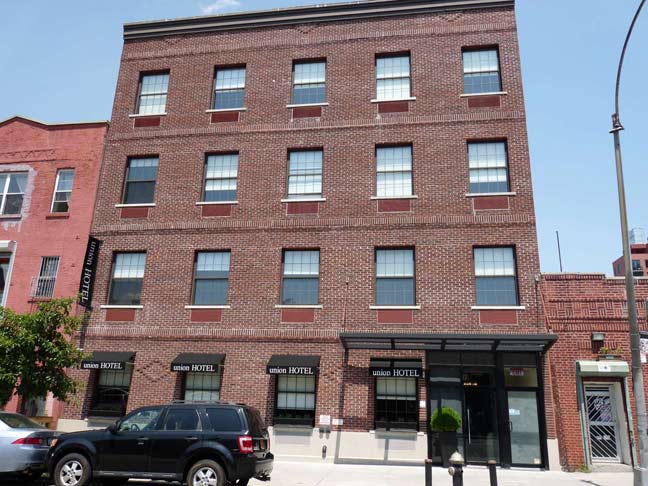
Lodgings, big and small, such as the Union Hotel are opening up all over Gowanus as an entertainment district seems to be straining mightily to establish itself on the ruins of industry. The hotel’s website describes itself thusly: “The Union Hotel celebrates New York City. Built with 19th century brick and mortar, The Union pays tribute to the factories and warehouses that built New York into the greatest city in the world.”
However, people who still work in the remaining area factories and warehouses are being priced out of the neighborhood.
What was once the Eureka Garage. How do I know it was a garage? The winged wheel motif is an almost universal NYC symbol (and elsewhere, perhaps).
But what is that thing on the roof? I see it on industrial buildings all the time.
At the SW corner of 4th avenue and DeGraw we come to one of Brooklyn’s most lavish painted ad works, showing off the long-departed Brooklyn Tile Supply Corp. Since 4th Avenue is reinventing itself as a strip of chi-chi-and-under hotels and condo high rises, its days are clearly numbered, so catch it while you can.
In mid-2014 an ashtray produced by the company was up for bid on Ebay.
Directly across DeGraw is a huge mural from a completely different era. It marks Diaspora Community Services, which provides a number of neighborhood services including anti-tobacco campaigns, support to HIV-positive individuals, TB screenings and infant mortality reduction.
The term diaspora comes from Greek for “scattering of seeds” and refers to any people or ethnic population forced or induced to leave their traditional ethnic homelands; being dispersed throughout other parts of the world, and the ensuing developments in their dispersal and culture. The original organization here was the Haitian Women’s Program.

After crossing 4th Avenue, DeGraw Street sticks a toe into Park Slope. You’d think 4th Avenue properties would be snapped up by now, but here’s a patch of weeds protected by barbed wire belying the statement.

Rows of attached brickfaced buildings and brownstones march up the hill, or slope, to Prospect Park. These have special bays that face both east and west to catch the light both ways — important styling when these buildings were constructed at the dawn of the Edison electrical revolution.

Remember at the top of the page when I praised #140 DeGraw for incorporating modernity into a brickface building? This isn’t as successful, as it just plops a new, noncontextual design among its old school brethren. It doesn’t work quite as well.

At 5th Avenue, DeGraw Street ends, and Lincoln Place begins. If you look at a Brooklyn map, several streets end at 5th while others begin: Sackett Street “becomes” Berkeley Place; Douglass, St. John’s Place; Butler, Sterling Place; Baltic, Park Place; Warren, Prospect Place. Wyckoff becomes St. Mark’s Place at 3rd Avenue, and is promoted to full Avenue at 5th. Other streets, like Carroll, President, Union, Bergen, Dean, Pacific Streets and Atlantic Avenue, don’t change their names but run all the way from Carroll Gardens or Cobble Hill all the way to East New York Avenue (in Union Street’s case, it runs south a couple of blocks to East 98th).
The streets aren’t continuous in all cases; some are off kilter by a few feet, while others, like DeGraw to Lincoln, are a straight line.
In 1873 Lizzie Lloyd King (a.k.a. Kate Stoddard, shot her lover, Charles Goodrich, to death after Goodrich ended the relationship. Stoddard stole Goodrich’s belongings and washed the corpse of blood. After a three-month investigation Stoddard was captured and was later committed to the State Lunatic Asylum in Auburn, NY.
Even while the case was being investigated, DeGraw Street from 5th to 6th Avenues was renamed for the 16th President, and eventually the full length of the street as far as East New York was so renamed.
The neighboring streets got new names, too, following a severe depression in 1873 to emphasize a suburban mood; Prospect Park got two streets renamed for it, while other streets received British-sounding names or historical figures such as Maryland’s Lord Stirling (in Brooklyn he got an “e” instead of an “i”).

I walked north on 5th Avenue, which FNY covered eons ago [2005] in Five Alive. Throughout high school and college, and even on bus rides with one parent or the other when I was a kid, I would take the B63 bus down 5th Avenue from Bay Ridge to downtown. Throughout much of that time, north of Carroll Street, 5th Avenue was a ghetto wasteland, with abandoned buildings with flowerpot stickers. These days it’s a “vibrant and diverse” western extension of Park Slope, with boutiques, bars and the occasional new condo, like the one pictured here. Quite a different beast from the 5th Avenue I grew up with. 5th is even tree-lined in spots, which I thought would never happen.
Believe it or not, the entire stretch from Flatbush Avenue to 38th Street was covered by an elevated train from 1888-1940.
This awning sign at 5th and Douglass was probably painted during the Reagan administration and only the VCR/CD references make it that young.

The first sign, to me at least, that 5th Avenue was “coming back” was when Butler Street was demapped and this giant Key Food and its parking lot were built in the roadbed in the early 1980s.

This row of storefronts, anchored by the bike and hardware shops, has been a mainstay even before the Key Food appeared and were a bright spot in the otherwise bombed-out 5th Avenue before the 1980s. 5th Avenue didn’t completely “gentrify” until the early 2000s and even now, it isn’t as exclusive as, say, 7th Avenue is.

Some pockets stubbornly resist, though.

Some relics here including Pope John Paul II, Joe Lhota (the Republican candidate for mayor in 2013) and a Merchants Association sticker from 1991

Storefront churches, left over from pregentrification, still dot upper 5th Avenue.

A grand corner turret at 5th Avenue and Warren Street. Remember, when this was built elevated trains rumbled past.

A tiled floor lists the street address.

I’m happy to see the El Viejo Yayo (“Old Yayo”) restaurant, now called Yayo’s Latin Cuisine, still going strong between Bergen and Dean Streets. It was established in the early 1960s. Yelp reviews are up and down.

McMahon’s Public House was a former “old man bar” called O’Connor’s. This Fifth-xture between Bergen and Dean since the 1930s has a new awning, replacing an old-time calligraphic sign that had been there since the 1970s. Wendy Mitchell, in New York City’s Best Dive Bars, observed: “O’Connor’s has made the leap from hard-drinking old-man bar to hipster paradise .. now that the crowds are here, the place can become packed on weekends, but at off-times it still maintains a bit of its old man Brooklyn appeal.”

The old Triangle Sports building, on the triangle formed by 5th and Flatbush Avenue and Dean Street, is still there, now dwarfed by the Inevitable Barclay’s. Triangle, which also had a branch on 5th Avenue and 83rd Street, was not only a sportswear emporium but was also the leading outfitter for Cub Scouts and Boy Scouts. My earned arrowheads in the Cub Scouts all came from there.
The Inevitable Barclay’s, I call it, since the efforts of the locals to stop it were, to me, inevitably futile. The fake rusty stadium is home to the Brooklyn Nets, soon the NY Islanders, as well as hip hop and awards shows. To me it’ll always ring a false note. Here used to stand the timeless Underberg Building housing restaurant supplies and a used-car lot where I’d wait for a bus to take me to high school. If I felt like walking, sometimes I’d stagger past swinging beeves by the slaughterhouses, yes, slaughterhouses and wholesale meat shops on the north side of Atlantic Avenue. Yes, this was Brooklyn’s meatpacking district.
Where Target and associated shops are now was the massive and decaying Long Island Rail Road terminal, which included a Bickford’s and a Schrafft’s. After the building could safely decay no more, it was razed, leaving a hole in the ground that sat for twenty years. Slowly grind the wheels of improving Brooklyn mass transit. A shiny, anodyne and boring terminal was eventually built.
Here’s what was torn down to create the Barclays and eventually, high rise housing.
Sick transit, Gloria!
8/31/14


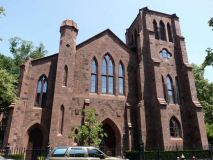






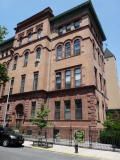




















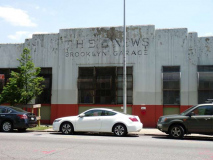

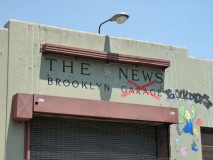
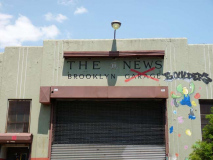



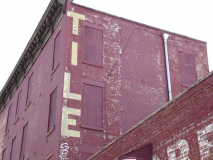


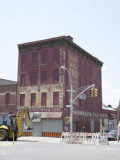

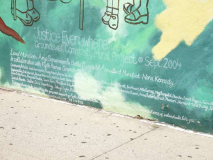
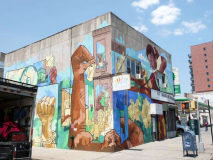




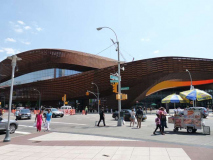
13 comments
Thank you for another great installment! Much of this narration can go with the pics I took on your S. Brooklyn tour last year. Amazing how in some areas we are light years ahead as far as preservation and architecture, over in Europe are buildings and neighborhoods that survived/preserved for hundreds of years, not here. It is a disgrace. Loved the link to your documentation of Ratnerville.
Oh my- I clearly meant “light years behind”! Need a little more coffee.
Here is a story about the National Packing Box Company on Union Street and the Gowanus. There used to be a business called Norsons at this location. They were furniture distributors. The owner was named Norman. His son was Irwin. As will happen to all of us, Norman died. Irwin took over the business.
Several weeks later, a worker was on the second floor of the building. He saw a man dressed in a black suit. Both looked at each other – then the guy in the suit disappeared. The worker freaked out and ran down the stairs to the office screaming. He eventually wound up at Irwin’s desk. Saw a picture of Norman and yelled “ES EL HOMBRE!”
Norman was a very informal guy. The only time we ever saw him in a suit was the black one he was buried in. He came back to make sure that the business was being run properly. Es el hombre, indeed.
Great story…
The photo of the Daily News building on 3rd Ave and DeGraw St. was the garage and maintenance center for their trucks. The printing plant was on Pacific St between 6th Ave and Vanderbilt Ave. I am from the area and enjoyed the story as I always do on your site.
Another great photo tour, Kevin.
Triangle Sports once had a location on the south side of Grand St., near Metropolitan Ave., in Williamsburg. It closed in the early 1980s. It was the go to place for those of us of a certain age (late ’60s-mid ’70s) to buy Pro Keds and “Lil Abner” boots.
Thanks for the nice walk thru my old neighborhood. Growing up on Union Street bet 5th and 6th in the 1950s-60s, we always sensed a great divide north (rougher, more transients and rooming houses, more Latino) and south (Italians galore, like my family). The Carroll-Union St stretch of Fifth was the heart of this Italian community, so much so that there was a race riot on the corner of Union and 5th in 1976, a violent spasm in a changing area. By the mid-80s, when we were looking to buy in, things were bleak, and dangerous, esp. north of Union, but even down to 3rd Street. We bought elsewhere, but should have known…. Having spent so much time trudging up Union from the R, I’m particularly fascinaed to see what becomes of this new hotel-bbq-beer hall college kid central.
I believe that Brooklyn Tile Supply was owned by my late uncle, Ben Worobow.
Kevin, you might have mentioned that, soaring above Key Food, is “The Willie”, a famous Brooklyn landmark…
http://www.hemmings.com/classifieds/dealer/ford/model_a/1678816.html?refer=news
Restoring the one in Brooklyn would cost more than buying this one.
Re Trinity German Lutheran Church:
Jehovah’s Witnesses are not at all the same as 7th Day Adventists (SDA).
At a glance, the sign appears to read, Don’t Litter 9-10:30 A.M. Wednesday. Like, that’s when the poor guy with the push broom comes by, doing a community service sentence, and it would be rude to drop your trash right then, wouldn’t it? Especially if he hasn’t finished anger management class. Someone could write a paper on the cognitive interpretation of mixed words and symbols. Not me though. I just comment.
Lord Stirling lived in New York and New Jersey (Basking Ridge) and was an officer in the American army during the Revolution.
This is my home. I have lived here forever and plan to stay forever and a day. I was raised here, my kids were raised here and I hope to one day have Grandchildren to be raised here. This is my neighborhood and I love it dearly. Thank you for understanding it so eloquently.
Deborah G.